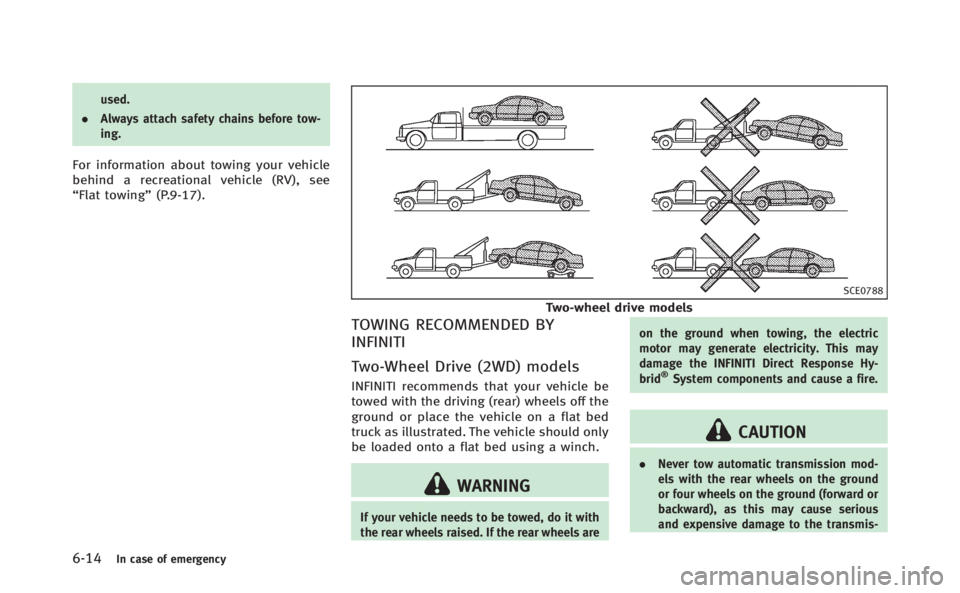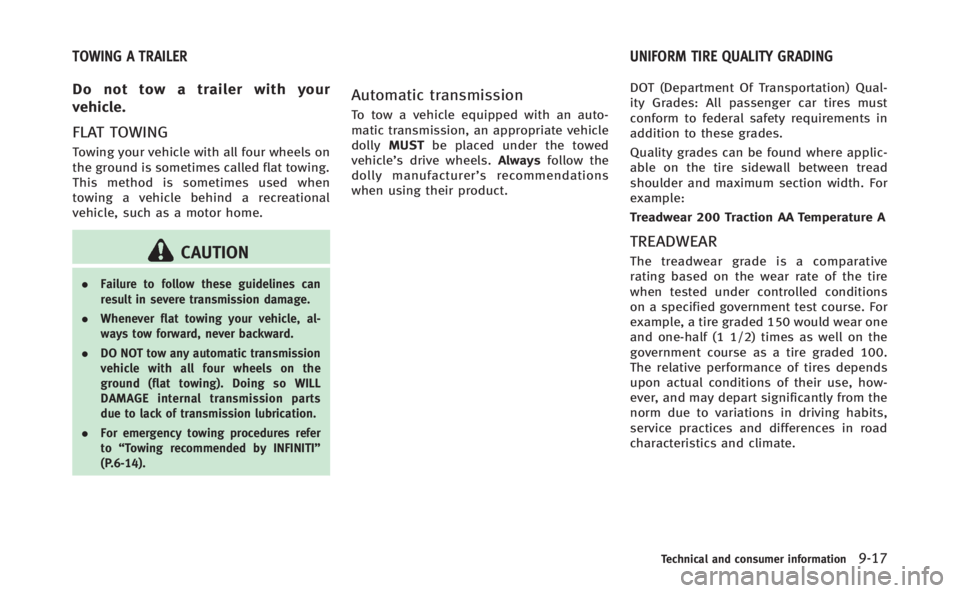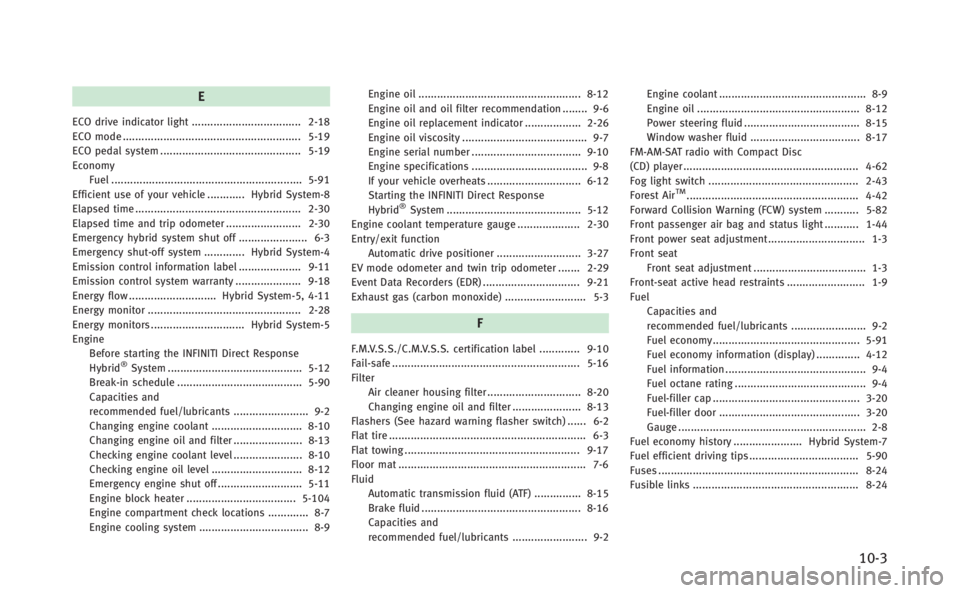towing INFINITI Q70 HYBRID 2014 Owner's Manual
[x] Cancel search | Manufacturer: INFINITI, Model Year: 2014, Model line: Q70 HYBRID, Model: INFINITI Q70 HYBRID 2014Pages: 522, PDF Size: 4.02 MB
Page 424 of 522

6 In case of emergency
Hazard warning flasher switch............................. 6-2
Roadside assistance program .............................. 6-2
Emergency INFINITI Direct Response Hybrid
®
System shut off ................................................... 6-3
Flat tire................................................................ 6-3 Tire Pressure Monitoring System (TPMS) ........ 6-3
Changing a flat tire ......................................... 6-4 If the vehicle does not start ................................ 6-9
Confirm battery is discharged ........................ 6-9
Jump starting .................................................... 6-10
Push starting .................................................... 6-12
If your vehicle overheats ................................... 6-12
Towing your vehicle .......................................... 6-13
Towing recommended by INFINITI ................. 6-14
Vehicle recovery (freeing a stuck vehicle) ..... 6-15
Page 435 of 522

6-12In case of emergency
7. Put the battery cover and fuse cover on.
NOTE:
If it is not possible to turn the hybrid
system ON by following this procedure,
contact an INFINITI retailer immediately.Do not attempt to start the engine by
pushing.
CAUTION
.
Automatic transmission models cannot
be push-started or tow-started. Attempt-
ing to do so may cause transmission
damage.
. Three way catalyst equipped models
should not be started by pushing since
the three way catalyst may be damaged.
. Never try to start the vehicle by towing
it; when the engine starts, the forward
surge could cause the vehicle to collide
with the tow vehicle.
. Hybrid models cannot be push-started or
tow-started. Attempting to do so may
cause electrical or transmission damage.
CAUTION
.Do not continue to drive if your vehicle
overheats. Doing so could cause engine
damage or a vehicle fire.
. To avoid the danger of being scalded,
never remove the radiator cap while the
engine is still hot. When the radiator cap
is removed, pressurized hot water will
spurt out, possibly causing serious
injury.
. Do not open the hood if steam is coming
out.
If your vehicle is overheating (indicated by
an extremely high temperature gauge
reading), or if you feel a lack of engine
power, detect abnormal noise, etc., take
the following steps:
1. Move the vehicle safely off the road,
apply the parking brake and move the
shift lever to the P (Park) position.
Do not turn the INFINITI Direct Re-
sponse Hybrid
®System off.
2. Turn off the climate control. Open all the windows, move the heater or air
conditioner temperature control to
PUSH STARTING IF YOUR VEHICLE OVERHEATS
Page 436 of 522

maximum hot and fan control to high
speed.
3. If engine overheating is caused by climbing a long hill on a hot day, run
the engine at a fast idle (approximately
1,500 rpm) until the temperature gauge
indication returns to normal.
4. Get out of the vehicle. Look and listen for steam or coolant escaping from the
radiator before opening the hood. (If
steam or coolant is escaping, turn off
the hybrid system.) Do not open the
hood further until no steam or coolant
can be seen.
5. Open the engine hood.
WARNING
If steam or water is coming from the engine,
stand clear to prevent getting burned.
6. Also check if the cooling fan is running. The radiator hoses and radiator should
not leak water. If coolant is leaking or
the cooling fan does not run, stop the
hybrid system.
WARNING
Be careful not to allow your hands, hair,
jewelry or clothing to come into contact
with, or get caught in, engine belts or the
engine cooling fan. The engine cooling fan
can start at any time.
7. After the engine cools down, check the coolant level in the reservoir tank with
the engine running. Add coolant to the
reservoir tank if necessary. Have your
vehicle repaired at the nearest INFINITI
retailer. When towing your vehicle, all State (Pro-
vincial in Canada) and local regulations for
towing must be followed. Incorrect towing
equipment could damage your vehicle.
Towing instructions are available from an
INFINITI retailer. Local service operators are
familiar with the applicable laws and
procedures for towing. To assure proper
towing and to prevent accidental damage
to your vehicle, INFINITI recommends that
you have a service operator tow your
vehicle. It is advisable to have the service
operator carefully read the following pre-
cautions.
WARNING
.
Never ride in a vehicle that is being
towed.
. Never get under your vehicle after it has
been lifted by a tow truck.
CAUTION
.When towing, make sure that the trans-
mission, axles, steering system and
powertrain are in working condition. If
any unit is damaged, dollies must be
In case of emergency6-13
TOWING YOUR VEHICLE
Page 437 of 522

6-14In case of emergency
used.
. Always attach safety chains before tow-
ing.
For information about towing your vehicle
behind a recreational vehicle (RV), see
“Flat towing” (P.9-17).
SCE0788
Two-wheel drive models
TOWING RECOMMENDED BY
INFINITI
Two-Wheel Drive (2WD) models
INFINITI recommends that your vehicle be
towed with the driving (rear) wheels off the
ground or place the vehicle on a flat bed
truck as illustrated. The vehicle should only
be loaded onto a flat bed using a winch.
WARNING
If your vehicle needs to be towed, do it with
the rear wheels raised. If the rear wheels are on the ground when towing, the electric
motor may generate electricity. This may
damage the INFINITI Direct Response Hy-
brid
®System components and cause a fire.
CAUTION
.
Never tow automatic transmission mod-
els with the rear wheels on the ground
or four wheels on the ground (forward or
backward), as this may cause serious
and expensive damage to the transmis-
Page 438 of 522

sion. If it is necessary to tow the vehicle
with the front wheels raised, always use
towing dollies under the rear wheels.
. When towing rear wheel drive models
with the front wheels on the ground or
on towing dollies: Push the ignition
switch to the ACC or ON position, and
secure the steering wheel in a straight-
ahead position with a rope or similar
device. For models with a steering wheel
lock mechanism: Never secure the steer-
ing wheel by selecting the LOCK posi-
tion. This may damage the steering lock
mechanism.
SCE0885
VEHICLE RECOVERY (freeing a stuck
vehicle)
WARNING
.Stand clear of a stuck vehicle.
. Do not spin your tires at high speed. This
could cause them to explode and result
in serious injury. Parts of your vehicle
could also overheat and be damaged.
Pulling a stuck vehicle
If your vehicle is stuck in sand, snow, mud,
etc., use a tow strap or other device
designed specifically for vehicle recovery.
Always follow the manufacturer’s instruc-
tions for the recovery device.
Front:
1. Remove the cover with a suitable tool.
2. Securely install the vehicle recovery
hook
*1stored with jacking tools as
illustrated. Attach the tow strap to the
recovery hook.
Make sure that the hook is properly
secured in the original place after use.
In case of emergency6-15
Page 439 of 522

6-16In case of emergency
Rear:
Do not use the tie down hook
*2for
towing or vehicle recovery.
CAUTION
. Tow chains or cables must be attached
only to the vehicle recovery hooks or
main structural members of the vehicle.
Otherwise, the vehicle body will be
damaged.
. Do not use the vehicle tie downs to free
a vehicle stuck in sand, snow, mud, etc.
. Never tow a vehicle using the vehicle tie
downs or recovery hooks.
. Always pull the cable straight out from
the front of the vehicle. Never pull on the
vehicle at an angle.
. Pulling devices should be routed so they
do not touch any part of the suspension,
steering, brake or cooling systems.
. Pulling devices such as ropes or canvas
straps are not recommended for use in
vehicle towing or recovery.
Rocking a stuck vehicle
If your vehicle is stuck in sand, snow, mud,
etc., use the following procedure:
1. Turn off the Vehicle Dynamic Control
(VDC) system.
2. Make sure the area in front and behind the vehicle is clear of obstructions.
3. Turn the steering wheel right and left to clear an area around the front tires.
4. Slowly rock the vehicle forward and backward.
.Shift back and forth between R
(Reverse) and D (Drive).
.Apply the accelerator as little aspossible to maintain the rocking
motion.
.Release the accelerator pedal beforeshifting between R and D.
.Do not spin the tires above 35 MPH(55 km/h).
5. If the vehicle cannot be freed after a few tries, contact a professional towing
service to remove the vehicle.
Page 490 of 522

9 Technical and consumer information
Capacities and recommended fuel/lubricants....... 9-2
Fuel information .............................................. 9-4
Engine oil and oil filter recommendation ......... 9-6
Air conditioning system refrigerant and
lubricant recommendations ............................. 9-7
Specifications ...................................................... 9-8
Engine............................................................. 9-8
Wheels and tires ............................................. 9-8
Dimensions ..................................................... 9-9
When traveling or registering your vehicle in
another country ................................................... 9-9
Vehicle identification ........................................... 9-9 Vehicle Identification Number (VIN) plate ......... 9-9
Vehicle identification number
(chassis number) ........................................... 9-10
Engine serial number .................................... 9-10
F.M.V.S.S./C.M.V.S.S. certification label .......... 9-10
Emission control information label ................ 9-11
Tire and loading information label ................. 9-11
Air conditioner specification label.................. 9-11 Installing front license plate .............................. 9-12
Vehicle loading information............................... 9-13 Terms .......................................................... 9-13
Vehicle load capacity ................................... 9-15
Loading tips................................................. 9-16
Measurement of weights.............................. 9-16
Towing a trailer ................................................. 9-17 Flat towing................................................... 9-17
Uniform tire quality grading .............................. 9-17 Treadwear .................................................... 9-17
Traction AA, A, B and C................................ 9-18
Temperature A, B and C ............................... 9-18
Emission control system warranty ..................... 9-18
Reporting safety defects.................................... 9-19
Readiness for Inspection/Maintenance (I/M) test
(US only)........................................................... 9-20
Event Data Recorders (EDR) ............................... 9-21
Owner’s Manual/Service Manual
order information .............................................. 9-21
Page 504 of 522

STI0365
VEHICLE LOAD CAPACITY
Do not exceed the load limit of your
vehicle shown as“The combined
weight of occupants and cargo” on
the Tire and Loading Information
label. Do not exceed the number of
occupants shown as “Seating Capa-
city” on the Tire and Loading In-
formation label.
To get “the combined weight of
occupants and cargo” , add the
weight of all occupants, then add the total luggage weight. Examples
are shown in the illustration.
Steps for determining correct load
limit
1.Locate the statement
“The com-
bined weight of occupants and
cargo should never exceed XXX kg
or XXX lbs” on your vehicle’ s
placard.
2.Determine the combined weight of
the driver and passengers that
will be riding in your vehicle.
3.Subtract the combined weight of
the driver and passengers from
XXX kg or XXX lbs.
4.The resulting figure equals the
available amount of cargo and
luggage load capacity. For exam-
ple, if the XXX amount equals
1400 lbs. and there will be five
150 lb. passengers in your vehi-
cle, the amount of available cargo
and luggage load capacity is 650
lbs. (1400 −750 (5 x 150) = 650
lbs or 640 −340 (5 x 70) = 300
kg.)
5.Determine the combined weight of
luggage and cargo being loaded
on the vehicle. That weight may
not safely exceed the available
cargo and luggage load capacity
calculated in Step 4.
6.If your vehicle will be towing a
trailer, load from your trailer will
be transferred to your vehicle.
Consult this manual to determine
how this reduces the available
Technical and consumer information9-15
Page 506 of 522

Do not tow a trailer with your
vehicle.
FLAT TOWING
Towing your vehicle with all four wheels on
the ground is sometimes called flat towing.
This method is sometimes used when
towing a vehicle behind a recreational
vehicle, such as a motor home.
CAUTION
.Failure to follow these guidelines can
result in severe transmission damage.
. Whenever flat towing your vehicle, al-
ways tow forward, never backward.
. DO NOT tow any automatic transmission
vehicle with all four wheels on the
ground (flat towing). Doing so WILL
DAMAGE internal transmission parts
due to lack of transmission lubrication.
. For emergency towing procedures refer
to“Towing recommended by INFINITI”
(P.6-14).
Automatic transmission
To tow a vehicle equipped with an auto-
matic transmission, an appropriate vehicle
dolly MUST be placed under the towed
vehicle’s drive wheels. Alwaysfollow the
dolly manufacturer’ s recommendations
when using their product. DOT (Department Of Transportation) Qual-
ity Grades: All passenger car tires must
conform to federal safety requirements in
addition to these grades.
Quality grades can be found where applic-
able on the tire sidewall between tread
shoulder and maximum section width. For
example:
Treadwear 200 Traction AA Temperature A
TREADWEAR
The treadwear grade is a comparative
rating based on the wear rate of the tire
when tested under controlled conditions
on a specified government test course. For
example, a tire graded 150 would wear one
and one-half (1 1/2) times as well on the
government course as a tire graded 100.
The relative performance of tires depends
upon actual conditions of their use, how-
ever, and may depart significantly from the
norm due to variations in driving habits,
service practices and differences in road
characteristics and climate.
Technical and consumer information9-17
TOWING A TRAILER
UNIFORM TIRE QUALITY GRADING
Page 514 of 522

E
ECO drive indicator light ................................... 2-18
ECO mode ......................................................... 5-19
ECO pedal system ............................................. 5-19
Economy
Fuel ............................................................. 5-91
Efficient use of your vehicle ............ Hybrid System-8
Elapsed time ..................................................... 2-30
Elapsed time and trip odometer ........................ 2-30
Emergency hybrid system shut off ...................... 6-3
Emergency shut-off system ............. Hybrid System-4
Emission control information label .................... 9-11
Emission control system warranty ..................... 9-18
Energy flow ............................ Hybrid System-5, 4-11
Energy monitor ................................................. 2-28
Energy monitors .............................. Hybrid System-5
Engine Before starting the INFINITI Direct Response
Hybrid
®System ........................................... 5-12
Break-in schedule ........................................ 5-90
Capacities and
recommended fuel/lubricants ........................ 9-2
Changing engine coolant ............................. 8-10
Changing engine oil and filter ...................... 8-13
Checking engine coolant level ...................... 8-10
Checking engine oil level ............................. 8-12
Emergency engine shut off ........................... 5-11
Engine block heater ................................... 5-104
Engine compartment check locations ............. 8-7
Engine cooling system ................................... 8-9 Engine oil .................................................... 8-12
Engine oil and oil filter recommendation ........ 9-6
Engine oil replacement indicator .................. 2-26
Engine oil viscosity ........................................ 9-7
Engine serial number ................................... 9-10
Engine specifications ..................................... 9-8
If your vehicle overheats .............................. 6-12
Starting the INFINITI Direct Response
Hybrid
®System ........................................... 5-12
Engine coolant temperature gauge .................... 2-30
Entry/exit function Automatic drive positioner ........................... 3-27
EV mode odometer and twin trip odometer ....... 2-29
Event Data Recorders (EDR) ............................... 9-21
Exhaust gas (carbon monoxide) .......................... 5-3
F
F.M.V.S.S./C.M.V.S.S. certification label ............. 9-10
Fail-safe ............................................................ 5-16
Filter Air cleaner housing filter .............................. 8-20
Changing engine oil and filter ...................... 8-13
Flashers (See hazard warning flasher switch) ...... 6-2
Flat tire ............................................................... 6-3
Flat towing ........................................................ 9-17
Floor mat ............................................................ 7-6
Fluid
Automatic transmission fluid (ATF) ............... 8-15
Brake fluid ................................................... 8-16
Capacities and
recommended fuel/lubricants ........................ 9-2 Engine coolant ............................................... 8-9
Engine oil .................................................... 8-12
Power steering fluid ..................................... 8-15
Window washer fluid ................................... 8-17
FM-AM-SAT radio with Compact Disc
(CD) player ........................................................ 4-62
Fog light switch ................................................ 2-43
Forest Air
TM....................................................... 4-42
Forward Collision Warning (FCW) system ........... 5-82
Front passenger air bag and status light ........... 1-44
Front power seat adjustment ............................... 1-3
Front seat Front seat adjustment .................................... 1-3
Front-seat active head restraints ......................... 1-9
Fuel Capacities and
recommended fuel/lubricants ........................ 9-2
Fuel economy............................................... 5-91
Fuel economy information (display) .............. 4-12
Fuel information ............................................. 9-4
Fuel octane rating .......................................... 9-4
Fuel-filler cap ............................................... 3-20
Fuel-filler door ............................................. 3-20
Gauge ............................................................ 2-8
Fuel economy history ...................... Hybrid System-7
Fuel efficient driving tips ................................... 5-90
Fuses ................................................................ 8-24
Fusible links ..................................................... 8-24
10-3